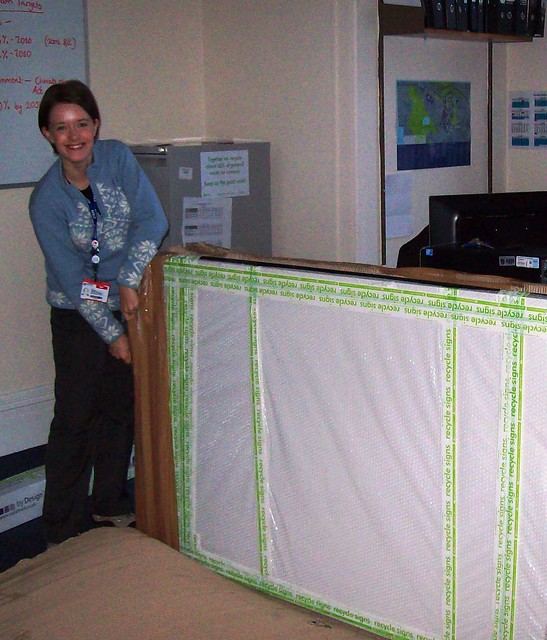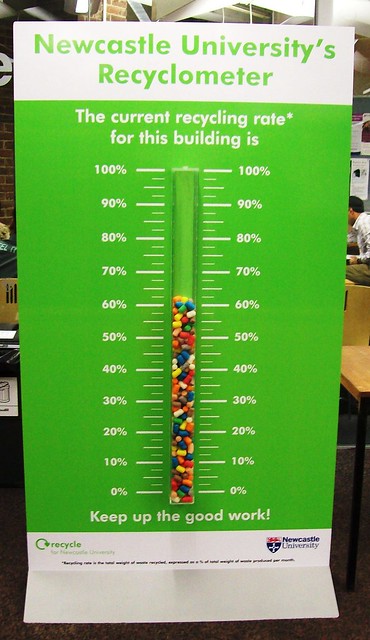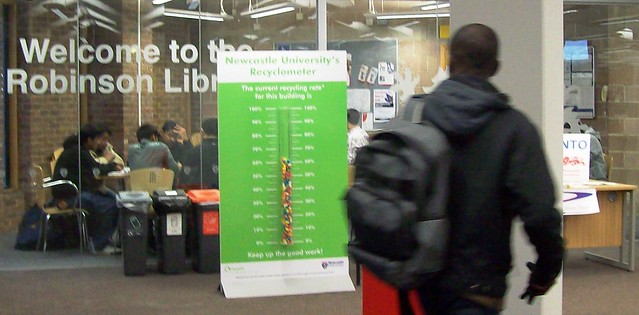When I was a kid, I was a huge Blue Peter fan – I even own a Blue Peter badge, thanks to a runner’s up prize to design a stamp when I was 10. So it’s understandable that I’d grow up with a ‘here’s one I made earlier!’ attitude.
When Julia Robinson, Environmental Co-ordinator for Robinson Library, suggested a Recyclometer, I jumped at the chance to help create it. Just like the Blue Peter fund-raising thermometers, a recyclometer would be a great way to visually show people the recycling rate for their building.
After looking into making a home-made version, it was decided that, even with a Blue Peter badge, the guys at Character Signs ( http://www.characterssigns.com/index.php ) could do a better job of bringing my vision to life.
A large, heavy parcel arrived several weeks later, and no time was wasted in ripping the masses of packaging off (all recycled, obviously). Despite the fact it took over an hour to unpack, once put together, the recyclometer was a thing of beauty – even better than my version using double sided tape and loo roll could have looked! The green shiny backing, the bright white lettering, the clear plastic tube…. have we finally made recycling cool?

The aim of the recyclometer is to publicise to all building users that the University is considering sustainability, and to let everyone know how good they are at recycling. It also adds in an element of competition, complimenting the Recycling League Table, to bring out the primal urge to meet the neighbouring building’s recycling rate. And hey, if that means we recycle more, then we welcome that urge.

So how does it work, I hear you ask? Each building has a recycling rate (that’s the percentage of all the waste created that is recycled). The recyclometer displays that rate using the clear plastic tube; the tube is filled with materials (re-used waste of course – remember the waste hierarchy?!) to match the percentage of the recycling rate. As each building has a different recycling rate, we needed the recyclometer to be able to display any percentage.

The recyclometer has just started its grand tour of campus, stopping off at each building over the coming months, starting with the Robinson Library. Look out for it in your building.
And FYI; it was the earth in a greenhouse (representing global warming) that was my fantastic entry in the stamp design competition – I was destined to work in sustainability!
By Kay Gregory, EC Support Officer, Aged 26 and a half.

How is the recycling rate for a building measured? Is it simply the percentage of waste that’s being recycled?
If so, this seems to be rewarding those buildings who are less environmentally friendly and waste paper – a building where people don’t print things out would be penalised since the percentage of their waste that’s recyclable would be considerably lower than a building where all the staff print out every e-mail then recycle it.
Obviously encouraging recycling is good but I would be concerned that staff in buildings who are making an effort to reduce total waste would feel discouraged by receiving a low score.
On behalf of Daniel O’Connor, Waste Manager for Newcastle University;
Hi Sean
The recycling rate is measured by expressing the total volume recycled over the total volume of waste produced.
It is a broad indicator of recycling performance.
All the buildings on campus actually perform very well all above 20%. All buildings are doing better than the average Council for instance.
I take your point though, but it is very hard to measure paper reduction measures. Do you think there are significant paper reduction measures being carried out?
The recycling rate is a % expression of the total waste produced. So if a building was actually reducing waste through reduced printing the total waste production would come down (less paper being produced) and the recycling rate would not be affected.
Thanks, Dan